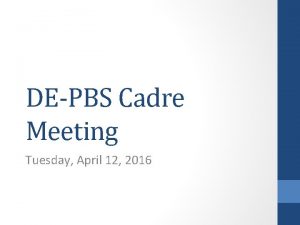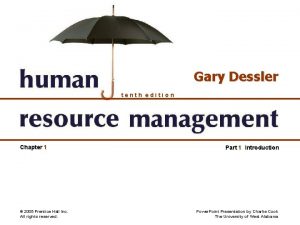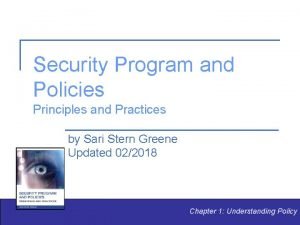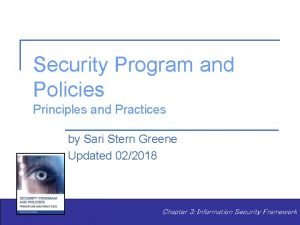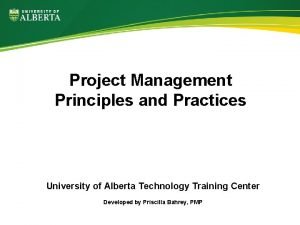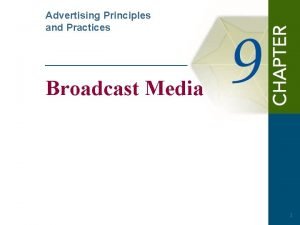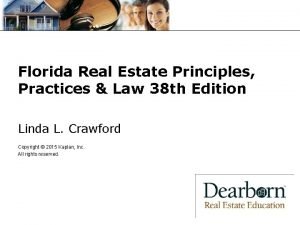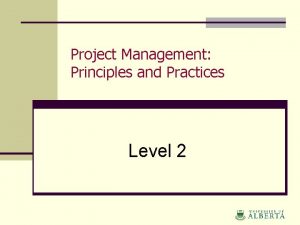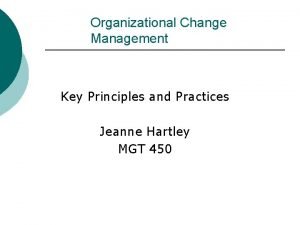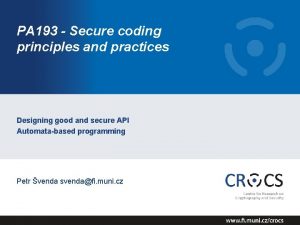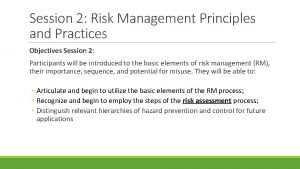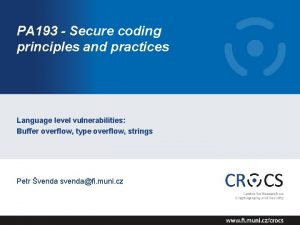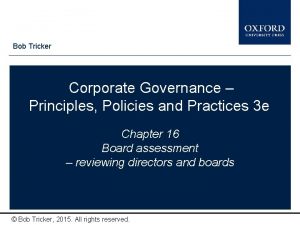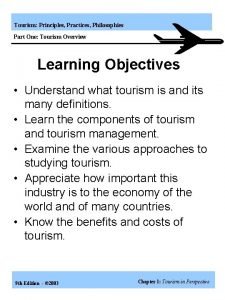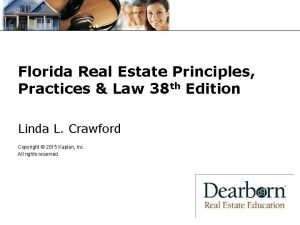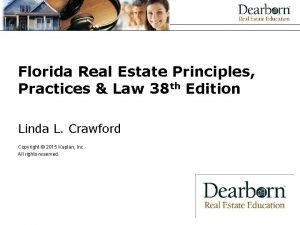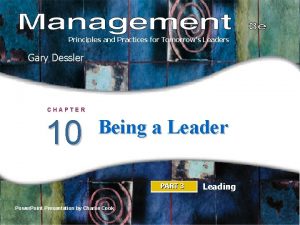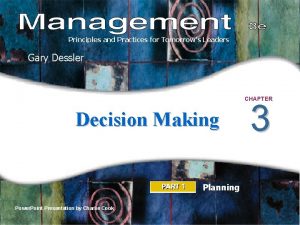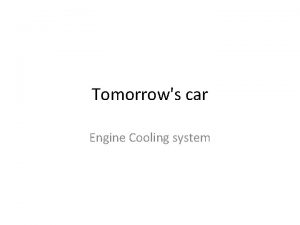Principles and Practices for Tomorrows Leaders Gary Dessler
















































- Slides: 48

Principles and Practices for Tomorrow’s Leaders Gary Dessler CHAPTER 11 Influencing Individual Behavior and Motivation The Environment of Managing Power. Point Presentation by Charlie Cook

Chapter Objectives After studying this chapter and the case exercises at the end, you should be able to: 1. Explain to the manager why the pay-for-performance incentive plan is not working. 2. Explain to the manager why his or her attempts to empower the employees have been ineffective. 3. Determine if the job is amenable to job enrichment and explain in detail how to enrich it. 4. Develop a behavior management program for the job in question. 5. Analyze the performance problem and recommend how to solve it. Copyright © 2004 Prentice Hall. All rights reserved. 2

What Managers Should Know About Individual Behavior • Motivation The intensity of a person’s desire to engage in an activity. • The Law of Individual Differences A psychological term representing the fact that people differ in their personalities, abilities, self-concept, values, and needs. • Three main approaches to motivation Need-based approach Process-based approach Learning/reinforcement-based approach. Copyright © 2004 Prentice Hall. All rights reserved. 3

Some Individual Determinants of Behavior FIGURE 11– 1 Copyright © 2004 Prentice Hall. All rights reserved. 4

Personality • Personality The characteristic and distinctive traits of an individual, and the way these traits interact to help or hinder the adjustment of the person to other people and situations. Copyright © 2004 Prentice Hall. All rights reserved. 5

Personality Types • Authoritarian Personality A personality type characterized by rigidity, intolerance of ambiguity, the tendency to stereotype others as being good or bad, and conformity to the requirements of authority. • Machiavellian Personality A personality type oriented toward manipulation and control, with a low sensitivity to the needs of others, the name of which refers to the sixteenth-century political advisor Niccolò Machiavelli. Copyright © 2004 Prentice Hall. All rights reserved. 6

Cattell’s 16 Personality Factors Source: Adapted from Gregory Northcraft and Margaret Neale, Organizational Behavior (Fort Worth, TX: Dryden Press, 1994), p. 87. Copyright © 2004 Prentice Hall. All rights reserved. FIGURE 11– 2 7

Measuring Personality • Myers-Briggs Type Indicator (MBTI) A tool for measuring personality in the work setting. MBTI classifications: v Extraverted or introverted (E or I) v Sensing or intuitive (S or N) v Thinking or feeling (T or F) v Perceiving or judging (P or J). The MBTI questionnaire classifies people into 16 different personality types (a 4 X 4 matrix) Copyright © 2004 Prentice Hall. All rights reserved. 8

Measuring Personality (cont’d) • Myers-Briggs Type Indicator (MBTI) (cont’d) Different personality types (the 4 X 4 matrix) are classified into one of four cognitive (thinking or problem-solving) styles: v Sensation–thinking (ST) v Intuition–thinking (NT) v Sensation–feeling (SF) v Intuition–feeling (NF) Some employers match the MBTI styles to particular occupations. Copyright © 2004 Prentice Hall. All rights reserved. 9

Four Examples of MBTI Styles and Some Corresponding Occupations FIGURE 0– 3 Copyright © 2004 Prentice Hall. All rights reserved. 10

Abilities and Behavior • Performance = Ability x Motivation • Types of abilities Mental, cognitive, or thinking abilities Mechanical ability Psychomotor abilities Visual skills Specific learned abilities (training, experience, or education) Copyright © 2004 Prentice Hall. All rights reserved. 11

Self-Concept and Behavior • Self-Concept The perceptions people have of themselves and their relationships to people and other aspects of life. • Self-Efficacy Being able to influence important aspects of one’s world; the belief that one can accomplish what one sets out to do. Copyright © 2004 Prentice Hall. All rights reserved. 12

Perception and Behavior • Perceptions How our personalities and experiences cause us to interpret stimuli. Perceptions are influenced by: v Personality and needs (self-efficacy) v Values (strong personal code of ethics) v Stress (health and environment) v Position in society or an organization • Stereotyping Associating certain characteristics with certain socioeconomic classes but not with others. Copyright © 2004 Prentice Hall. All rights reserved. 13

Perception FIGURE 11– 4 Copyright © 2004 Prentice Hall. All rights reserved. 14

Attitudes and Behavior • Attitude A predisposition to respond to objects, people, or events in either a positive or negative way. Attitudes are important because they can influence how people behave on the job. Good (or bad) performance is not necessarily associated with good (or bad) attitudes. • Job Satisfaction The measure of an employee’s attitude about his or her job. Copyright © 2004 Prentice Hall. All rights reserved. 15

Attitudes and Behavior (cont’d) • The Job Descriptive Index measures five aspects of job satisfaction: 1. Pay. How much pay is received, and is it perceived as equitable? 2. Job. Are tasks interesting? Are opportunities provided for learning and for accepting responsibility? 3. Promotional opportunities. Are promotions and opportunities to advance available and fair? 4. Supervisor. Does the supervisor demonstrate interest in and concern about employees? 5. Co-workers. Are coworkers friendly, competent, and supportive? Copyright © 2004 Prentice Hall. All rights reserved. 16

Need-based Approaches To Motivation • Motive Something that incites a person to action or that sustains and gives direction to action. • Motivational Dispositions or Needs Motives that lie dormant until the proper conditions arise bring them forth or make them active. • Aroused Motive A motive that expresses itself in behavior. Copyright © 2004 Prentice Hall. All rights reserved. 17

Need-based Approaches To Motivation (cont’d) • Maslow’s Needs-Hierarchy Theory People have a hierarchy of five increasingly higherlevel needs: v Physiological, security, social, self-esteem, and self- actualization. Prepotency Process Principle v People are motivated first to satisfy the lower-order needs and then, in sequence, each of the higher-order needs. Copyright © 2004 Prentice Hall. All rights reserved. 18

Maslow’s Hierarchy of Needs FIGURE 11– 5 Copyright © 2004 Prentice Hall. All rights reserved. 19

Need-based Approaches To Motivation (cont’d) • Existence Relatedness Growth (ERG) Theory Alderfer’s theory of human needs focuses on three needs: existence, relatedness, and growth. v Existence needs are similar to Maslow’s physiological and security needs. v Relatedness needs are those that require interpersonal interaction to satisfy (prestige and esteem from others). v Growth needs are similar to Maslow’s needs for selfesteem and self-actualization. Copyright © 2004 Prentice Hall. All rights reserved. 20

Need-based Approaches To Motivation (cont’d) • Herzberg’s Hygiene-Motivator (Two-Factor) Approach Reduces Maslow’s hierarchy to: v Hygienes: lower-level (physiological, safety, social) v Motivators: higher-level (ego, self-actualization) needs. Posits that the best way to motivate is to arrange the job (job enrichment) so that it provides intrinsic satisfaction of higher-level needs, since these needs are constantly recurring and relatively insatiable. Copyright © 2004 Prentice Hall. All rights reserved. 21

Summary of Herzberg’s Motivator– Hygiene Findings FIGURE 11– 6 Source: Adapted from Frederick Herzberg, “One More Time: How Do You Motivate Employees, ” Harvard Business Review, January–February 1968. Copyright © 2004 Prentice Hall. All rights reserved. 22

Need-based Approaches To Motivation (cont’d) • Needs for Achievement, Power, and Affiliation The Need for Achievement v. A predisposition to strive for success and the satisfaction of accomplishing a challenging task or goal. The Need for Power v. A desire to influence others directly by making suggestions, giving opinions and evaluations, and trying to talk others into things. The Need for Affiliation v The motivation to maintain strong, warm relationships with friends and relatives. Copyright © 2004 Prentice Hall. All rights reserved. 23

What’s Happening Here? Source: David A. Kolb, Irwin M. Rubin, and James M. Mc. Intyre, Organizational Psychology: An Experiential Approach (Upper Saddle River, NJ: Prentice Hall, 1971), p. 55. Copyright © 2004 Prentice Hall. All rights reserved. FIGURE 11– 7 24

Process Approaches To Motivation • Adams’s Equity Theory People have a need for, and therefore value and seek, fairness in employer–employee relationships. If a person perceives an inequity, a tension or drive will develop in the person’s mind, and the person will be motivated to reduce or eliminate the tension and the perceived inequity. v Employees can do this by reducing what they put into the job, or by boosting the magnitude of the rewards they take out (or both). v It matters less what the reality is than how the person perceives his or her inputs and outputs as compared with the other (referent) person’s. Copyright © 2004 Prentice Hall. All rights reserved. 25

How a Perceived Inequity Can Affect Performance FIGURE 11– 8 Copyright © 2004 Prentice Hall. All rights reserved. 26

Process Approaches To Motivation (cont’d) • Locke’s Goal Theory of Motivation People regulate their behavior in such a way as achieve their goals. v. A person’s goals provide the mechanism through which unsatisfied needs are translated into actions. v Unsatisfied needs prompt the person to seek ways to satisfy those needs; the person then formulates goals that prompt action. Copyright © 2004 Prentice Hall. All rights reserved. 27

Process Approaches To Motivation (cont’d) • Goal Theory of Motivation Findings Specific, challenging goals lead to higher task performance than specific, unchallenging goals, or vague goals or no goals, when: v Feedback showing progress towards the goals is provided. v Appropriate task strategies are used when tasks are complex. v Individuals have adequate abilities. v There is a commitment to accomplishing the goals. Copyright © 2004 Prentice Hall. All rights reserved. 28

Checklist 11. 1 Setting Effective Goals þ Set SMART goals—make them specific, measurable, attainable, relevant, and timely. þ Choose relevant and complete results areas (sales revenue, costs, and so forth). þ Assign specific goals. þ Assign measurable goals. þ Assign doable but challenging goals. þ Encourage participation. þ Use management by objectives. Copyright © 2004 Prentice Hall. All rights reserved. 29

Process Approaches To Motivation (cont’d) • Vroom’s Expectancy Theory People are conscious agents who are continually sizing up situations in terms of their perceived needs and then acting in accordance with these perceptions. • Motivation = E x I x V E represents expectancy (probability of success) I is instrumentality (correlation) V is valence (value of a particular reward) Copyright © 2004 Prentice Hall. All rights reserved. 30

Process Approaches To Motivation (cont’d) • Vroom’s Expectancy Theory (cont’d) Expectancy v The probability that a person’s efforts will lead to performance. Instrumentality v The perceived correlation between successful performance and obtaining the reward. Valence v The perceived value a person ascribes to the reward for certain efforts. Copyright © 2004 Prentice Hall. All rights reserved. 31

Learning/Reinforcement Approaches To Motivation • Learning A relatively permanent change in a person that occurs as a result of experience. Motivation based on experience tends to be instinctive rather than a product of a deliberate thought process (as is process-based motivation). Copyright © 2004 Prentice Hall. All rights reserved. 32

Learning/Reinforcement Approaches To Motivation (cont’d) • B. F. Skinner and Operant Behavior Operant behavior v Behavior that appears to operate on or have an influence on the subject’s environment. Contingent reward v. A reward that is contingent or dependent on performance of a particular behavior. Copyright © 2004 Prentice Hall. All rights reserved. 33

Learning/Reinforcement Approaches To Motivation (cont’d) • Behavior Modification The technique of changing or modifying behavior through the use of contingent rewards or punishments. Behavior modification has two basic principles: v Behavior that leads to a reward tends to be repeated, whereas behavior that leads to punishment tends not to be repeated. v It is possible to get a person to learn to change his or her behavior by providing the properly scheduled rewards. Copyright © 2004 Prentice Hall. All rights reserved. 34

Motivation In Action: Ten Methods For Motivating Employees 1. Set Goals 2. Use Pay for Performance 3. Improve Merit Pay 4. Use Recognition 5. Use Positive Reinforcement Copyright © 2004 Prentice Hall. All rights reserved. 6. Use Behavior Management 7. Empower Employees 8. Enrich the Jobs 9. Use Skill-Based Pay 10. Provide Lifelong Learning 35

Use Pay for Performance • Pay for Performance Compensation methods based on merit/performance rather than across-the-board nonoutput-based pay. • Variable Pay Plan A compensation plan that reduces or increases a portion of an employee’s pay, depending on whether the company meets its financial goals. • Gainsharing Plan An incentive plan that engages employees in a common effort to achieve a company’s productivity objectives and in which they share in the gains. Copyright © 2004 Prentice Hall. All rights reserved. 36

Checklist 11. 2 How to Implement An Incentive Plan 1. Make sure effort and rewards are directly related. 2. Make the plan easy to understand. 3. Set effective standards. 4. View the standard as a contract with your employees. 5. Get employee support for the plan. 6. Use good measurement systems. 7. Emphasize long-term as well as short-term success. 8. Take the system into account. Copyright © 2004 Prentice Hall. All rights reserved. 37

Improving Merit Pay • Merit Raise A salary increase—usually permanent—based on individual performance. • Applying merit raises more intelligently Clarify performance standards before the measurement period begins. Institute a performance appraisal system to systematically and accurately evaluate performance. Award merit pay based on merit rather than as an across-the-board increase in compensation. Tie award allocations to limited specific timeframes. Copyright © 2004 Prentice Hall. All rights reserved. 38

Positive Reinforcement Rewards MONETARY Salary increases or bonuses Company-paid vacation trip Discount coupons Company stock Extra paid vacation days Profit sharing Paid personal holiday Movie/athletic event passes Free/discount airline tickets Discounts on company products or services Gift selection from catalog Copyright © 2004 Prentice Hall. All rights reserved. STATUS SYMBOLS Bigger desk Bigger office or cubicle Exclusive use of fax machine Freedom to personalize work area Private office Cellular phone privileges On-line service privileges FIGURE 11– 9 Source: Several items under the job- and career-related category are from Dean R. Spitzer, “Power Rewards: Rewards That Really Motivate, ” Management Review, May 1996, p. 48. 39

Copyright © 2004 Prentice Hall. All rights reserved. 40

Use Behavior Management • Positive Reinforcement Rewarding desired behavior; or the actual rewards, such as praise or bonuses, given each time the desired behavior occurs. • Extinction Withholding positive reinforcement so that the undesired behavior disappears over time. • Negative Reinforcement Reinforcing the desirable behavior by removing something undesirable from the situation. Copyright © 2004 Prentice Hall. All rights reserved. 41

Use Behavior Management (cont’d) • Punishment Applying penalties for the undesired behavior to reduce the possibility that it will recur. • Schedules of Reinforcement Continuous reinforcement v Produces rapid learning of behavior. Variable reinforcement v Produces sustained behavior. Copyright © 2004 Prentice Hall. All rights reserved. 42

Options for Modifying Behavior with Reinforcement FIGURE 11– 10 Copyright © 2004 Prentice Hall. All rights reserved. 43

Performance Improvement Project Worksheet FIGURE 11– 11 Source: Lawrence Miller, Behavior Management: The New Science of Managing People at Work (New York: John Wiley, 1978), p. 18. Copyright © 2004 Prentice Hall. All rights reserved. 44

Empower Employees • Empowerment The act of giving employees the authority, tools, and information they need to do their jobs with greater autonomy and confidence. Copyright © 2004 Prentice Hall. All rights reserved. 45

Enrich the Jobs • Job Enrichment The inclusion of opportunities for achievement and other motivators in a job by making the job itself more challenging. • Job Enrichment Techniques Form natural work groups. Combine tasks. Establish client relationships Vertically load the job. Open feedback channels. Copyright © 2004 Prentice Hall. All rights reserved. 46

Enrich the Jobs • Job Design The number and nature of specific tasks or activities in a job. • Job Enlargement An increase in the number of similar tasks assigned to a job. • Job Rotation The systematic movement of a worker from job to improve job satisfaction and reduce boredom. Copyright © 2004 Prentice Hall. All rights reserved. 47

How to Analyze Performance. Motivation Problems FIGURE 11– 14 Source: Copyright Gary Dessler, Ph. D. Suggested in part by “Performance Diagnosis Model, ” David Whetton and Kim Cameron, Developing Management Skills (Upper Saddle River, NJ: Prentice Hall, 2001), p. 339. Copyright © 2004 Prentice Hall. All rights reserved. 48
 Line and staff aspects of hrm
Line and staff aspects of hrm Hrm by gary dessler
Hrm by gary dessler Gary dessler
Gary dessler Roi metrics
Roi metrics Tomorrow's technology and you
Tomorrow's technology and you Sjacl
Sjacl Planning alternative tomorrows with hope
Planning alternative tomorrows with hope Planning alternative tomorrows with hope
Planning alternative tomorrows with hope Tomorrows doctors
Tomorrows doctors All tomorrows mbti
All tomorrows mbti White e lippitt propõem três estilos de liderança
White e lippitt propõem três estilos de liderança Alexander fleming
Alexander fleming Hr strategy map
Hr strategy map Dessler 2005
Dessler 2005 Security program and policies principles and practices
Security program and policies principles and practices Security program and policies principles and practices
Security program and policies principles and practices Security program and policies principles and practices
Security program and policies principles and practices Security program and policies principles and practices
Security program and policies principles and practices Security program and policies principles and practices
Security program and policies principles and practices Rasic chart
Rasic chart Broadcasting principles and practices
Broadcasting principles and practices Florida real estate principles practices & law
Florida real estate principles practices & law Project management principles and practices
Project management principles and practices Change management principles and practices
Change management principles and practices Milady infection control
Milady infection control Current issues in classroom testing
Current issues in classroom testing Secure coding principles and practices
Secure coding principles and practices Language assessment principles and classroom practices
Language assessment principles and classroom practices Risk management principles and practices
Risk management principles and practices Corrupted size vs. prev_size:
Corrupted size vs. prev_size: Tricker corporate governance
Tricker corporate governance Tourism: principles, practices, philosophies
Tourism: principles, practices, philosophies Involuntary inactive real estate license florida
Involuntary inactive real estate license florida 8 principles of evidence based practices
8 principles of evidence based practices Florida real estate principles practices
Florida real estate principles practices Florida real estate principles practices & law
Florida real estate principles practices & law Florida real estate principles practices & law 43rd edition
Florida real estate principles practices & law 43rd edition Florida real estate principles practices
Florida real estate principles practices Kontinuitetshantering i praktiken
Kontinuitetshantering i praktiken Novell typiska drag
Novell typiska drag Tack för att ni lyssnade bild
Tack för att ni lyssnade bild Returpilarna
Returpilarna Varför kallas perioden 1918-1939 för mellankrigstiden?
Varför kallas perioden 1918-1939 för mellankrigstiden? En lathund för arbete med kontinuitetshantering
En lathund för arbete med kontinuitetshantering Kassaregister ideell förening
Kassaregister ideell förening Personlig tidbok för yrkesförare
Personlig tidbok för yrkesförare Anatomi organ reproduksi
Anatomi organ reproduksi Densitet vatten
Densitet vatten Datorkunskap för nybörjare
Datorkunskap för nybörjare







